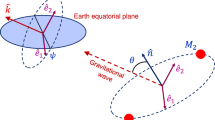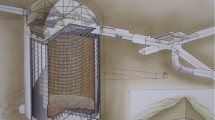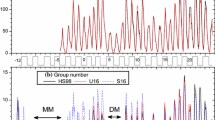Abstract
The invention of the neutron monitor pile for the study of cosmic-ray intensity-time and energy changes began with the discovery in 1948 that the nucleonic component cascade in the atmosphere had a huge geomagnetic latitude dependence. For example, between 0° and 60° this dependence was a ∼ 200–400% effect – depending on altitude – thus opening the opportunity to measure the intensity changes in the arriving cosmic-ray nuclei down to ∼1–2 GeV nucl−1 for the first time. In these measurements the fast (high energy) neutron intensity was shown to be a surrogate for the nuclear cascade intensity in the atmosphere.
The development of the neutron monitor in 1948–1951 and the first geomagnetic latitude network will be discussed. Among its early applications were:
(1) to prove that there exists interplanetary solar modulation of galactic cosmic-rays (1952), and;
(2) to provide the evidence for a dynamical heliosphere (1956).
With the world-wide distribution of neutron monitor stations that are presently operating (∼ 50) many novel investigations are still to be carried out, especially in collaborations with spacecraft experiments.
Similar content being viewed by others
References
Agnew, H. M., Bright, W. C., and Froman, D.: 1947, 'Distribution of Neutrons in the Atmosphere', Phys. Rev. 72, 203.
Babcock, H. W.: 1953, 'The Solar Magnetograph', Astrophys. J. 118, 397–396.
Bethe, H. A., Korff, S. A., and Placzek, G.: 1940, 'On the Interpretation of Neutron Measurements in Cosmic Radiation', Phys. Rev. 57, 573.
Blau, M. and Wambacher, H.: 1937, 'Disintegration Processes by cosmic-rays with Simultaneous Emission of Several Heavy Particles', Nature 140, 585.
Carmichael, H.: 1964, IQSY Instruction Manual 7, Deep River, Canada.
Chupp, E. L., Debrunner, H., Flückiger, E., Forrest, D. J., Golliez, F., Kanbach, G., Vestrand, W. F., Cooper, J. J., and Share, G.: 1987, 'Solar Neutron Emissivity During the Large Flare on 1982 June 3', Astrophys. J. 318, 913–925.
Compton, A. H., Wollan, E. O., and Bennett, R. D.: 1934, 'A Precision Recording Cosmic-Ray Meter', Rev. Sci. Instrum. 5, 415.
Davis, L., Jr.: 1955, 'Interplanetary Magnetic Fields and cosmic-rays', Phys. Rev. 100, 1440.
Debrunner, H., Flückiger, E. O., Chupp, E. L., and Forrest, D. J: 1983, 'The Solar cosmic-ray Neutron Event on June 3, 1982', Proc. 18th Int. cosmic-ray Conf., Bangalore 4, 75–78.
Forbush, S. E.: 1954, 'World-Wide cosmic-ray Variations, 1937–1952', J. Geophys. Res. 59, 525.
Forbush, S. E.: 1958, 'cosmic-ray Variations, 1937–1952', J. Geophys. Res. 63, 651.
Forbush, S. E.: 1993, in J. A. VanAllen (ed.), cosmic-rays, the Sun and Geomagnetism: The Works of Scott E. Forbush, American Geophys. Union, Washington, D.C., Science 262, 1912.
Katz, L., Meyer, P., and Simpson, J. A.: 1958, 'Further Experiments Concerning the Geomagnetic Field Effective for cosmic-ray', Nuovo Cimento (Suppl.) 8, 277.
Korff, S. A.: 1939, 'Recent Studies at High Elevations', Rev. Mod. Phys. 11, 211.
Lattes, C. M. G., Occhialini, G. P. S., and Powell, C. F.: 1947, 'Observations on the Tracks of Slow Mesons in Photographic Emulsions', Nature 160, 453–486.
Libby, W. F.: 1946, 'Atmospheric Helium Three and Radiocarbon from Cosmic Radiation', Phys. Rev. 69, 671.
Libby, W. F.: 1955, Radiocarbon Dating, University of Chicago Press, Chicago, Ill.
Meyer, P. and Simpson, J. A.: 1955, 'Changes in the Low Energy Particle Cut-Off and Primary Spectrum of Cosmic Radiation, I', Phys. Rev. 99, 1517.
Meyer, P. and Simpson, J. A.: 1957, 'Changes in the Low Energy Particle Cutoff and Primary Spectrum of Cosmic Rays, II', Phys. Res. 106, 568.
Meyer, P., Parker, E. N., and Simpson, J. A.: 1956, 'The Solar cosmic-rays of February 1956 and Their Propagation Through Interplanetary Space', Phys. Rev. 104, 768.
Morrison, P.: 1956, 'Solar Origin of cosmic-ray Time Variations', Phys. Rev. 101, 1397.
Parker, E. N.: 1956, 'Solar Origin of cosmic-ray Time Variations', Phys. Rev. 110, 1445.
Parker, E. N.: 1963, Interplanetary Dynamical Processes, Interscience, New York.
Pyle, K. R.: 1993, 'The Haleakala cosmic-ray Neutron Monitor Station: Intercalibration With the Huancayo Station', Proc. 23rd Int. cosmic-ray Conf. 3, 609.
Rose, D. C., Katzman, J., Fenton, K. B., and Simpson, J. A.; 1956, 'Latitude Effect of the Cosmic Ray Nucleon and Meson Components at Sea Level from the Arctic to the Antarctic', Can. J. Phys. 34, 968.
Schein, M., Jesse, W. P., and Wollan. E. O.: 1941, 'The Nature of the Primary Cosmic Radiation and the Origin of the Mesotron', Phys. Rev. 59, 615.
Simpson, J. A., Jr.: 1948, 'The Latitude Dependence of Neutron Density in the Atmosphere as a Function of Altitude', Phys. Rev. 73, 1389.
Simpson, J. A.: 1951, 'Neutrons Produced in the Atmosphere by the Cosmic Radiations', Phys. Rev. 83, 1175.
Simpson, J. A.: 1953, 'Flying Atomic “Piles”', University of Chicago Magazine 45 (4), 5.
Simpson, J. A.: 1957, The International Geophysical Year, University of Chicago Citizens Board, University of Chicago Press.
Simpson, J. A.: 1958, 'Cosmic Radiation Neutron Intensity Monitor', Annals of the Int. Geophysical Year IV, Part VII, Pergamon Press, London, p. 351.
Simpson, J. A.: 1985, in H. Elliot and Y. Sekido (eds.), 'Cosmic-Ray Astrophysics at Chicago (1947–1960)', Early History of cosmic-ray Studies, D. Reidel Publ. Co., Dordrecht, Holland, p. 385.
Simpson, J. A.: 1994, 'A Physicist in the World of Geophysics and Space', J. Geophys. Res. 99, 19 159–19 173.
Simpson, J. A.: 1998, 'A Brief History of Recurrent Solar Modulation of the Galactic cosmic-rays (1937–1990)', Space Sci. Rev. 83, 169–176.
Simpson, J. A. and Uretz, R. B.: 1953, 'Cosmic-Ray Neutron Production in Elements as a Function of Latitude and Altitude', Phys. Rev. 90, 44.
Simpson, J. A., Baldwin, H.W., and Uretz, R. B.: 1951, 'Nuclear Bursts Produced in the Low Energy Nucleonic Component of the Cosmic Radiation', Phys. Rev. 84, 332.
Simpson, J. A., Firor, J., Fonger, W. H., and Treiman, S. B.: 1953a, Recueil des Travaux de L'Observatoire du Pic-du-Midi, Bagnères de Bigorre (France), 2–4.
Simpson, J. A., Fonger, W., and Treiman, S. B.: 1953b, 'Cosmic Radiation Intensity-Time Variations and Their Origin, I. Neutron Intensity Variation Method and Meteorological Factors', Phys. Rev. 90, 934.
Simpson, J. A., Babcock, H. W., and Babcock, H. D.: 1955, 'Association of a “Unipolar” Magnetic Region on the Sun With Changes of Primary Cosmic-Ray Intensity', Phys.Rev. 98, 1402.
Treiman, S. B.: 1952, 'Analysis of the Nucleonic Component Based on Neutron Latitude Variations', Phys. Rev. 86, 917–923.
Author information
Authors and Affiliations
Rights and permissions
About this article
Cite this article
Simpson, J.A. The Cosmic Ray Nucleonic Component: The Invention and Scientific Uses of the Neutron Monitor – (Keynote Lecture). Space Science Reviews 93, 11–32 (2000). https://doi.org/10.1023/A:1026567706183
Issue Date:
DOI: https://doi.org/10.1023/A:1026567706183




